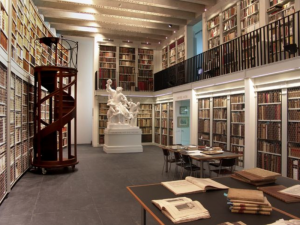 Un bel composto: Mediality in the Baroque
Un bel composto: Mediality in the Baroque
Twenty-first International Baroque Summer Course of the Werner Oechslin Library Foundation, Einsiedeln
Introduction:
“The opinion is widespread that Bernini was the first to attempt to unite architecture with sculpture and painting in such a manner that together they make a beautiful whole.” The words of Filippo Baldinucci, referring to Gian Lorenzo Bernini, have become a commonplace since Irving Lavin’s book Bernini and the Unity of the Visual Arts (1980). What is outlined here with the term “bel composto” (a beautiful whole) is however in no way limited to Bernini or even the Italian baroque in its aesthetic quality. And not only the three arts mentioned here are subsumed by it, but the list would have to be expanded to others: music, dance, poetry, all the way to ephemeral formats such as fireworks or fountains.
The concept of mediality, which emerged in the context of new social media, is essentially characterized by its multi-mediality, that is, by its capacity to join together different manifestations of media. This has recently led to the development of the concept of historical mediality, which deals with similar phenomena of the past. What is essential with this is, on one hand, fusion as the result of an artistic process, on the other hand – and as a premise, as it were – a reflection about the nature and possibilities of the most diverse aesthetic qualities in relation to a larger whole. Particularly in the baroque period artists understood how to combine very different expressive possibilities and materials and to create coherent new entities (un bel composto) from them in an exemplary manner. Every conception inspired by classicism, guided by the primacy of drawing, must stand diametrically opposed to such an attitude. The bel composto could never properly establish itself in the French regions, and it was finished off by the European classicism of the late eighteenth century.
Thus, the Baroque Summer Course examines the potential of individual genres to be brought into an amalgamation with other arts. Contributions can comprise theoretical reflections about the phenomenon itself or about individual genres as well as case studies that can illustrate the issue in an exemplary manner.
The course is open to doctoral candidates as well as junior and senior scholars who wish to address the topic with short papers (20 minutes) and through mutual conversation. As usual, the course has an interdisciplinary orientation. We hope for lively participation from the disciplines of art and architectural history, but also from scholars of history, theology, theatre and other relevant fields. Papers may be presented in German, French, Italian or English; at least a passive knowledge of German is a requirement for participation.
Conditions: The Foundation assumes the hotel costs for course participants, as well as several group dinners and the excursion. Travel costs cannot be reimbursed.
Please send applications with brief abstracts and brief CVs by e-mail to:
anja.buschow@bibliothek-oechslin.ch
The CFP deadline is 15 January 2020.
Concept / Organization: Dr. Anja Buschow Oechslin (Einsiedeln), Prof. Dr. Axel Christoph Gampp (Uni Basel), Prof. Dr. Stefan Kummer (Uni Würzburg), Prof. Dr. Werner Oechslin (Einsiedeln).

Leave a Reply
You must be logged in to post a comment.